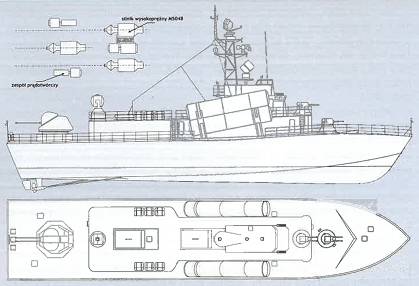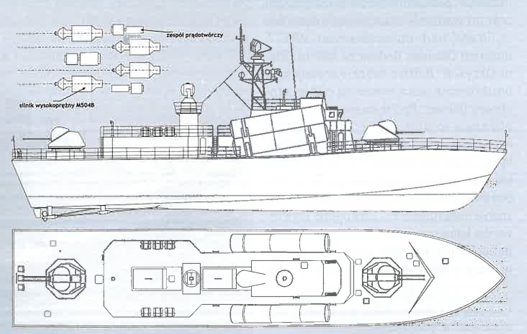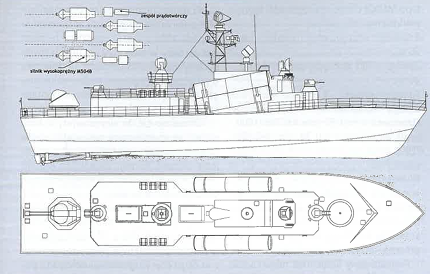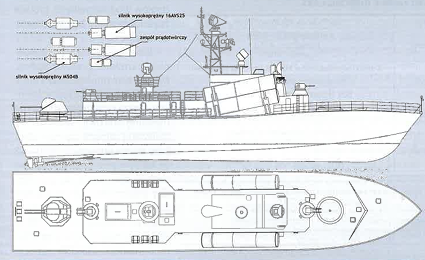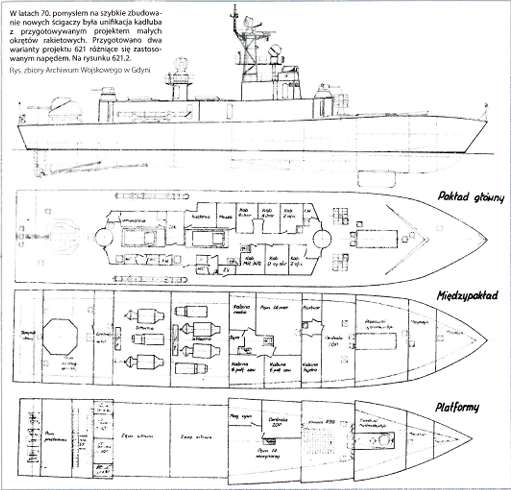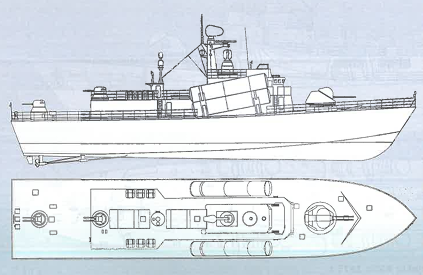In this post I will write about the latest plans for cruisers of the Polish Navy, i.e. post-war ones.
So I'll start at the beginning.
In the fall of 1945, work on the future structure of the Polish Navy began at the Naval Command. These included proposals for positions for organizational units that were to be established in 1946. Several variants were prepared, below is one of the variants that was prepared.
One of such documents assumed the following, among other things:
destroyer squadron that was to be based in Gdynia (ORP Piorun, ORP Garland, ORP Burza, ORP Błyskawica and a fifth destroyer that has no name)
A corvette squadron was supposed to be based in Świnoujście, these are three Hunt II-class escort destroyers.
And here something needs to be explained.
At that time, the majority of the DMW were Russians, so Soviet ships from the Baltic fleet and those interned in Great Britain were also included.
In the next document that interests us more, dated October 29, 1945, positions were established for:
2 destroyers, i.e. ORP Błyskawica and ORP Burza
4 submarines, i.e. ORP Sęp, all 3 Wilk class submarines
9 trawlers with a displacement of 100 tons
12 submarine chasers
2 torpedo boats
I am not mentioning smaller ships.
It was an attempt to put together the ships promised by the USSR, those interned in Sweden, and those that were Polish property.
However, this was a minimal plan.
A month later, another document was developed at the Naval Main Staff.
It assumed, among other things, the takeover of ships that were Polish property, including those that were transferred to Poland on the basis of the Polish-British agreement signed in the first months of the war.
This fleet was then to consist of
1 cruiser,
5 destroyers (these are ORP Burza, ORP Błyskawica, in turn, the destroyers transferred under the Polish-British agreement were ORP Kujawiak, for sure, unfortunately sunk, those that survived the war were ORP Garland and ORP Piorun, the next destroyer under this agreement was ORP Orkan destroyer unfortunately sunk, my comment)
2 corvettes (probably ORP Krakowiak and ORP Ślązak, my comment)
6 submarines,
9 trawlers,
16 submarine chasers,
4 torpedo boats,
a training ship and a tanker.
The document itself is dated November 1945, so it was prepared shortly before the personnel changes in December.
The Polish-British agreement I am writing about included the takeover of ships that were in good technical condition, equipped and capable of entering service.
We asked for the transfer of the cruiser on the basis of the above Polish-British agreement, as was done with several destroyers and the ORP Dzik submarine, ORP Dragon did not meet the conditions of this agreement, we were interested in the Dido or Fiji class, we took over ORP Dragon to gain experience, and then when the situation would allow it, we could get a new cruiser, but I will write more about ORP Dragon another time, so it was proposed to replace ORP Dragon with, among others, HMS Royalist, HMS Diadem, Dido type or Arethusa type, but when we lost ORP Dragon, we were given a second cruiser class D, since we knew this ship, just to clarify.
Therefore, I have doubts whether the above cruiser is ORP Conrad (at the moment).
Another naval program with cruisers was presented on November 26, 1946 by Adam Mohuczy.
It was a fleet expansion program for the years 1947–1959.
It included, among others
5 light cruisers with a displacement of 4,215 tons
12 destroyers with a displacement of 2,000-2,200 tons
20 submarines with a displacement of 250-350 tons.
The tonnage of the entire fleet was 59,675 tons.
The presentation of this naval program accelerated the departure of Rear Admiral Mohuczy, and the plan was withdrawn by his successor, Włodzimierz Steyer.
Now I will try to solve the puzzle regarding this displacement, and what kind of cruisers these could be (potentially closest to what the Poles wanted back then) if this naval program was implemented.
So 2 things to start with
a) from what I know, these cruisers were to be delivered between 1953 and 1959 (remember, according to the naval program).
So this excludes existing ships such as the D-class or C-class.
The option of building such a cruiser in Polish shipyards according to your own design should also be ruled out because it is not possible.
b) displacement 4215 tons
In Poland in the 1940s there were editions of Jane FS and Weyers.
In Jane FS 44–45 the full displacement of 4,215 tons of the light cruiser Tromp was given.
And here I need to write something more about this ship.
Light cruiser Tromp was something intermediate between a large destroyer and a cruiser, or more specifically, a flotilla leader, but due to its armament it was called a light cruiser.
After the war, light cruisers of this displacement were no longer built, so the displacement of 4,215 tons is derived from the Tromp ship, with the understanding that a small, heavily armed ship just like Tromp can be built to achieve a displacement close to the full displacement of 4,215 tons, which is why the light cruiser Tromp was a cruiser here model, in other words, a starting point for what future Polish cruiser could be.
To sum it all up, we are talking about a flotilla leader/armored destroyer that could be called a light cruiser like Tromp, small light cruiser or a large destroyer of approximately the full displacement of 4,215 tons.
In such a situation, the only direction seems to be the USSR, because it would not be possible to build new ships in Great Britain or the USA, so it should be assumed that the project would be Soviet, because although there was a government of national unity at that time, the communists had the majority, Besides, Poland's main ally at that time was the USSR.
And this brings us to the question of what kind of ships they could be.
In fact, I know of two main ships that could have met the expectations of the Poles, which is what they were thinking about at the time.
I will provide here the data of the ships that I know, which are closest to what was thought about, not everyone may associate or know them.
1. Project 47
Project 47, as I would say, was supposed to be an armored destroyer/flotilla leader, after the war the concept of destroyer armor was returned, project 47 can be compared to ships such as the Dido class cruiser or the Tromp class, in general it is the project closest to the ship that was being thought about when creating naval program in 1946 (because I don't know what else to compare it to, especially when we take into account Soviet projects).
The closest to what was wanted is the project 47 designed by V.Ya.Shur in 1940, although it is larger than the Tromp.
Data for this project
Standard displacement 3,800 tons,
normal displacement 4000 tons
dimensions
length 150 m
width 13.6 m
armament: 4xII 130 mm B-2-U
4xII 37 mm 66 K
2x5 533 mm torpedo tubes
armor from 100 to 25 mm.
Speed 38 knots
2. Project 40 base version.
Project 40 was a large destroyer project developed in 1942–1945.
It was a large destroyer that had the following data (I am giving the data from the table on the Lesta wiki, there is data for all variants as well as a graphic of the variant in question)
standard displacement 3,300 tons, normal displacement 3,765 tons, and full displacement 4,230 tons.
dimensions
length 130 meters
width 13.4 m
draft 4.15 m
Armament: 3xII 130 mm B-2-U universal guns
10 37 mm guns
2xIII 533 mm torpedo tubes.
Although it is difficult to say today what specific ship could be built because it depends on many things, and I am not able to answer it, I could tell you why I did not consider projects with SM-2-1 turrets.
You see, the truth is that the USSR would not provide us with designs with such main turrets until they had such weapons.
For example, it was not possible for Poland to acquire Project 56 destroyers in the 1950s.
If anything, the Russians would be more willing to provide the project with the B 2 U or BL 109 turrets or a newer variant (because I'm not sure what else was available in the 130 mm caliber), and yes, hypothetically, Russia could provide Poland with the post-war project 47, but not with 130 mm SM-2-1 main turrets, if anything it would have to be a modified design with other 130 mm guns.
I think I have written quite a lot about what is behind these cruisers, and what it could be if the naval program was continued, so let this be a conclusion and summary.
If anyone knows more Russian designs with armor or others of this type that could be compared, you can write, see the tips I posted.
It was also the last naval program with cruisers (currently).
The last mention of a cruiser for Poland dates back to the late 1950s/early 1960s, at which time Russia was supposed to hand over one of the Baltic fleet cruisers to Poland.
There is more information in the Russian archives.
Below is a bibliography regarding the sources of fleet organization, naval program, displacement and data of potential ships.
Morze Statki i Okręty WS 1/2015 article Weteran w nowej szacie. ORP Burza w marynarce wojennej PRL by Robert Rochowicz, Morza i Okręty WS 5/2016 article Trudny rok 1945, czyli okręty, których nie było by Robert Rochowicz,
https://fow.pl/forum/viewtopic.php?t=5275&start=64 , for project 40
https://wiki.lesta.ru/ru/Navy:Эскад...D0.B5.D0.BA.D1.82.D1.8B_.D0.A6.D0.9A.D0.91-17 , for project 47
https://wiki.lesta.ru/ru/Navy:Лидер...2..D0.AF._.D0.A8.D1.83.D1.80.D0.B0_.281940.29 , and wikipedia for project 47
https://ru.wikipedia.org/wiki/Лидер...екта_47#Разработка_нового_варианта_проекта_47 .





